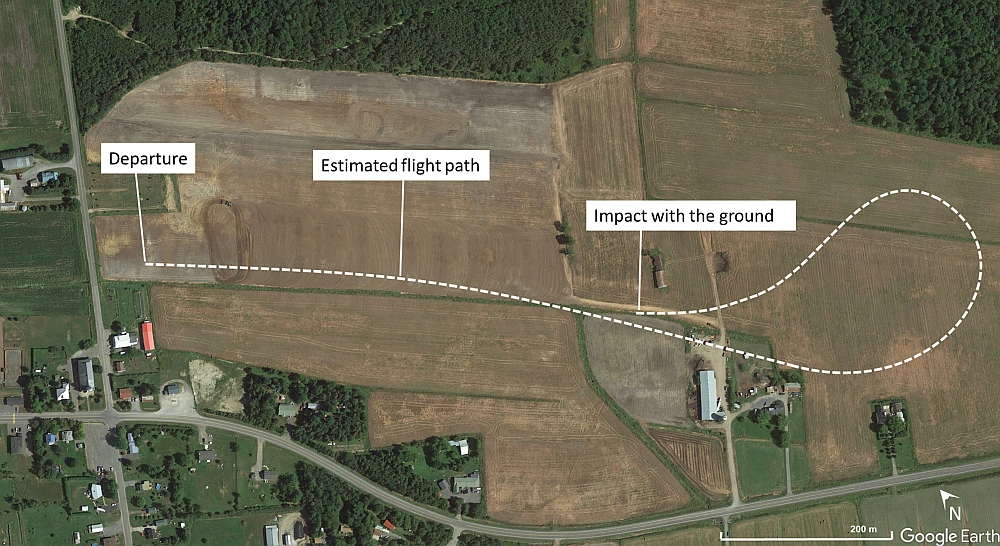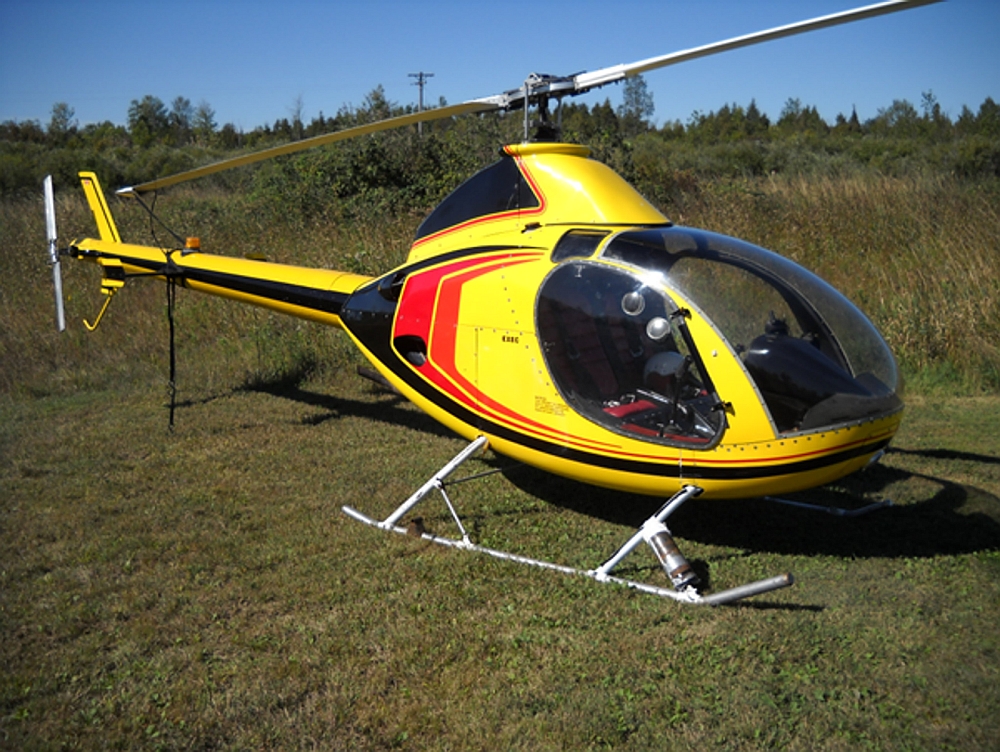Main rotor blade failure in flight
Unregistered
RotorWay Exec (amateur-built helicopter)
Lefebvre, Quebec
The Transportation Safety Board of Canada (TSB) investigated this occurrence for the purpose of advancing transportation safety. It is not the function of the Board to assign fault or determine civil or criminal liability. This report is not created for use in the context of legal, disciplinary or other proceedings. See Ownership and use of content. Masculine pronouns and position titles may be used to signify all genders to comply with the Canadian Transportation Accident Investigation and Safety Board Act (S.C. 1989, c. 3).
History of the flight
At around 1200Footnote 1 on 29 November 2022, the owner/pilot of the amateur-built RotorWay Exec helicopter (unregistered, serial number RBB1996) pulled the aircraft out of his garage in the Municipality of Lefebvre, Quebec, with the assistance of a family member. The pilot intended to conduct a local visual flight rules flight from the private field beside his garage.
The pilot, who was alone on board, started the engine and let it run for approximately 10 minutes. He then brought the helicopter into a hover less than 1 m above the ground and continued to hover for approximately 30 seconds. The family member who had assisted the pilot was filming the aircraft with his cellphone. The pilot then climbed, flying along the field in a southeasterly direction over an estimated distance of approximately 0.5 nautical miles (NM) before turning back toward his point of departure.
According to an analysis of the video, the flight took place at a maximum height of approximately 154 feet above ground level. On the way back, the pilot began a descent and, shortly afterwards, fragments separated from the aircraft as the aircraft began to break up in flight and drop. Approximately 2 minutes after takeoff, the aircraft struck the ground at a steep angle and ended up in a ditch marking the boundary of a field approximately 0.3 NM southeast of the point of departure (Figure 1).
Emergency services were notified of the crash, and first responders arrived at the accident site shortly afterward. The pilot was fatally injured. The aircraft was destroyed by the impact forces, and there was no post-impact fire. The aircraft was not equipped with an emergency locator transmitter.
Weather information
The graphic area forecast Clouds and Weather chart, issued at 1225 and valid at 1300, forecast a broken ceiling at 3000 feet above sea level and visibility greater than 6 statute miles. The Drummondville weather station, located 11 NM northeast of the point of departure, indicated surface winds from the east-northeast between 2 and 5 mph (between 1.7 and 4.3 knots).
The weather was suitable for this visual flight rules flight and was not considered a factor in this accident.
Pilot information
The pilot held a Canadian airline transport pilot licence – aeroplane and a Category 1 medical certificate, both of which were valid. He held the following ratings: single-engine and multi-engine (landplane and seaplane), Group 1 instrument flight, and Class 3 instructor.
He did not have a Transport Canada helicopter pilot licence and was not authorized to exercise the privileges of such a licence.
There was no indication that the pilot had completed any training flights with a qualified flight instructor as a helicopter student pilot. The pilot’s personal log could not be found.
According to subsection 401.03(1) of the Canadian Aviation Regulations (CARs),
[s]ubject to subsection (2), no person shall act as a flight crew member or exercise the privileges of a flight crew permit, licence or rating unless
- the person holds the appropriate permit, licence or rating;
- the permit, licence or rating is valid;
- the person holds the appropriate medical certificate; and
- the person can produce the permit, licence or rating, and the certificate, when exercising those privileges.Footnote 2
According to information gathered during the investigation, there was no indication that the pilot’s performance was affected by medical, pathological, or physiological factors.
Aircraft information
The aircraft, an amateur-built 2-seat, 2-bladed RotorWay Exec helicopter (Figure 2), was equipped with a 150 hp 4-cylinder RotorWay RW152 liquid-cooled engine. The aircraft had been registered for the first time in March 1996 (registration C-FXOA). The certificate of registration was cancelled on 24 July 2018 by the owner at the time. According to information gathered, the occurrence pilot reportedly acquired the occurrence helicopter in July 2018, but Transport Canada did not receive a registration application for this aircraft; therefore, it had not been registered since July 2018.
When the flight authority was issued, the aircraft had an empty weight of 970 pounds and a maximum take-off weight of 1500 pounds.
In July 2018, when the occurrence pilot purchased the aircraft, the hour meter read 256 hours. At the time of the occurrence, the hour meter read 310.5 hours.
Accident site and examination of the wreckage
The aircraft was lying on its left side in a ditch between 2 fields. The tail boom was fractured, but was still attached to the fuselage by the tail rotor control cable and electrical wiring. Ground impact marks were observed approximately 6 m southwest of the fuselage.
One of the 2 main rotor blades was still in one piece and showed damage consistent with that caused by the impact that had occurred. However, the aluminum skins on the upper and lower surfaces of the 2nd blade (see the Main rotor blades section) were missing. The leading edge of the 2nd blade was still attached to the rotor head and showed no signs of having struck a bird or object in flight. Several fragments of the main rotor blade skin were found southwest of the wreckage, with the furthest being approximately 116 m from the point of impact (Figure 3). The cockpit doors and roof broke off in flight and were found between the aircraft and the furthest blade fragment.
Flight control continuity between the cockpit and the main rotor was confirmed, and the blade pitch could move freely. The tail rotor blade pitch could also move freely, but control continuity could not be confirmed because of the damage.
Aircraft maintenance
All aircraft must be maintained in accordance with a maintenance scheduleFootnote 3 that lists the scheduled inspections to be carried out. The depth of these inspections must be “consistent with the general condition and operating role of the aircraft.”Footnote 4 A maintenance schedule must be approved by the Minister except when the owner of a small aircraft that is not being used for commercial operations decides to comply with appendices B and C of CARs Standard 625. One of the requirements in Appendix B that refers to the performance of maintenance states that “[t]he method of inspection for each item on the maintenance schedule shall be in accordance with the manufacturer’s recommendations or standard industry practice.”Footnote 5
For amateur-built aircraft, as well as for owner-maintained aircraft, the person who performs the maintenance is not required to hold an aircraft maintenance engineer licence. However, according to the information note in Standard 571, which provides clarification on section 571.02 of the CARs, “[p]ersons who perform maintenance or elementary work are required to follow the manufacturer’s recommendations, or equivalent practices.”Footnote 6 For amateur-built aircraft, maintenance instructions may have been published by the kit provider. These instructions could serve as the basis for a manufacturer (the person who builds the aircraft) who decides to develop specific recommendations. The person who performs the maintenance must also meet CARs requirementsFootnote 7 with respect to technical records by documenting all maintenance actions in these records.
In this occurrence, the manufacturer had not developed specific recommendations; however, the kit provider’s Airframe Information & Operations Material Manual contains pre- and post-flight checklistsFootnote 8 as well as a list of the types of operations to avoidFootnote 9 because they may be detrimental to blade life. The person inspecting the blades must ensure, among other things, that there is no separation between the leading edge and the upper and lower skin, and that the blade tip end plugs are secure.
The investigation was unable to determine whether the pilot was familiar with and had followed the kit provider’s instructions or other maintenance requirements.
Main rotor blades
Asymmetrically shaped main rotor blades consist primarily of 2 aluminum skins bonded and riveted to a D-shaped aluminum extrusion, which forms the leading edge. The skins are riveted and bonded together where they overlap to form the trailing edge. The blades are hollow; they do not contain any honeycomb structure or filler material (Figure 4).
The technical examination of the blade fragments and the video showing the start of the accident sequence helped to determine that the joint between the leading edge and the skin had separated, resulting in the complete separation of the skins and the loss of control of the aircraft by the pilot.
After a thorough examination, it was determined that the helicopter experienced an in-flight breakup of one of its main rotor blade assemblies. There was no pre-existing damage to the skins themselves, although the skin bond lines exhibited significant areas of adhesive failure.
It is most probable that the adhesive failures on both the upper and lower skins near the leading edge of the rotor tip allowed the high tip aerodynamic loads to force the skins from the main spar. A subsequent loss of torsional stiffness allowed the blade spar to deflect, causing the complete loss of both the upper and lower skins.
Other similar occurrences
The investigation uncovered 2 other occurrences involving RotorWay Exec helicopters and conditions similar to those of this occurrence.
The first occurrence took place on 28 March 1992 in Coalport, Shropshire, United Kingdom. The investigation by the United Kingdom’s Air Accidents Investigation Branch determined that the lower skin of one of the main rotor blades had delaminated and separated from the leading edge in flight, which caused the pilot to lose control of the helicopter. The delamination near the blade tip had been caused by water infiltration. Deficiencies were identified with the pre-flight inspections and storage.Footnote 10
The 2nd occurrence took place on 02 October 1992 in Wimberley, Texas, United States. According to the U.S. National Transportation Safety Board, delamination of the skin on one of the main rotor blades was a probable cause of the accident.Footnote 11 However, the cause of the delamination could not be determined.
TSB laboratory reports
The TSB completed the following laboratory reports in support of this investigation:
- LP051/2023 – RotorWay rotor examination
- LP029/2023 – Video analysis
Safety messages
Owners and pilots of amateur-built aircraft and of owner-maintained aircraft must ensure that they fully understand the regulations and that they have all technical data applicable to their aircraft, including data from the kit provider, the manufacturer, and the component manufacturer.
They must also ensure that all maintenance activities, including inspections, and operating procedures comply with these technical data to ensure that the aircraft remains airworthy.
This report concludes the Transportation Safety Board of Canada’s investigation into this occurrence. The Board authorized the release of this report on . It was officially released on .



![Cross-sectional view of a main rotor blade (Source: RotorWay International, drawing 1 of 2 E20-1000, Main rotor blade assembly [17 July 1982], with TSB annotations)](/sites/default/files/eng/rapports-reports/aviation/2022/a22q0142/images/a22q0142-figure-04.jpg)